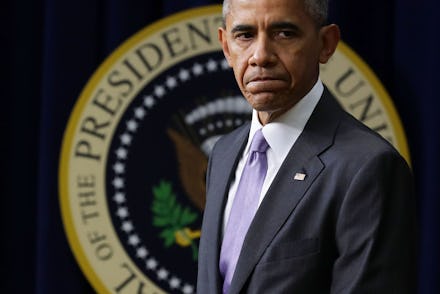What we learned about President Obama from 'Barry,' the new Netflix biopic

Vikram Gandhi's biopic on President Barack Obama, titled Barry, has come to Netflix. The Toronto International Film Festival selection began streaming on the online platform on Dec. 16. Barry takes place in 1981, when Obama was a junior transfer student at Columbia University in New York.
"This is an incredibly unique American story and it's stranger than fiction," Gandhi told NBC News. "When we think about Barack Obama's story — it's about what it means to be an American."
Here are three things that biopic viewers will learn about the the president's life at Columbia.
Obama struggled with fitting in.
Obama's mother was a white woman from Kansas, while his father was a black man from Kenya. Barry shows that Obama had trouble adjusting to his mixed-race identity during his youth. The biopic trailer includes a snippet with young Barry disagreeing with his classmate, who tells him that, as a biracial person, he can fit in anywhere. Barry retorts that he doesn't belong in white spaces or black ones.
"Barack Obama, to me, is an embodiment of not just black America, but of mixed-race America, a multicultural America," Gandhi told Forbes. "What I'm trying to do is tell the story of a mixed-race kid in New York in 1981 that would one day become the 44th President of the United States."
Devon Terrell, the Australian-born character who plays the biopic's titular character, told Forbes that his own struggle with identity has echoed Obama's in some ways.
"I have lived a very similar life to Obama in certain respects," he said. "I'm of mixed race, as well. It's the story of this young mana trying to discover his own path forward. I'm going through that right now myself."
He lived in a violent neighborhood.
Barry roomed with a Pakistani student in Morningside Heights, which, at the time, was considered a dangerous place. He enjoyed playing basketball in Morningside Park, not far from his home. At the basketball court one day, someone gave Barry the nickname "Invisible," because they saw him reading Ralph Ellison's Invisible Man, which matched the Columbia student's common feeling of not being seen.
Despite living in a rough neighborhood, Barry attended a prestigious university. His Columbia days meant constantly relating to different kinds of people, both rich and poor, black and white. New York allowed him to straddle class and race lines in manners he had never done before.
Seeing New York housing projects changed his life.
Gandhi told Forbes that the scene where Barry tours a public housing project is a crucial one. It captures Barry confronting the reality of America's racial divide in a way he had never experienced before.
"Obama grew up in Hawaii and lived in Indonesia before moving five blocks from an Ivy League university and 10 blocks from Harlem," said Gandhi. "We wanted to show him seeing the real plight of poverty in Harlem and the dark side of Africa-American culture in New York at the time."
Observing the projects made Barry realize that African-Americans needed support. This realization prompted him to become a community organizer, which set him on the path to eventually pursue a career in law and politics.